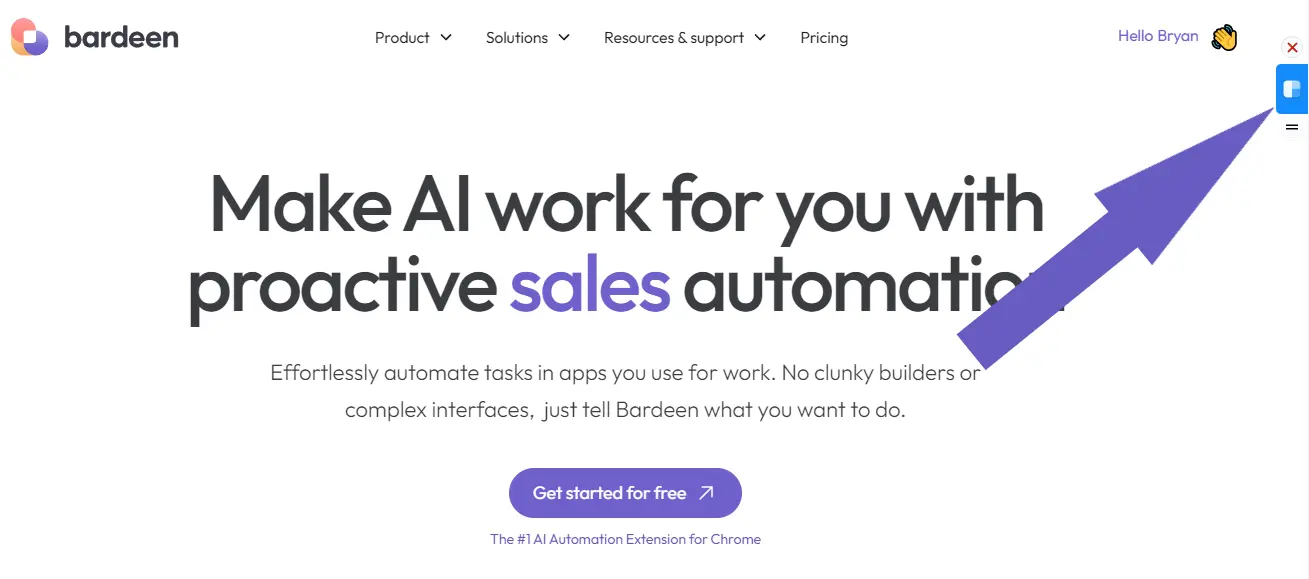





Direct sales means selling products directly to customers without intermediaries.
By the way, we're Bardeen, we build a free AI Agent for doing repetitive tasks.
If you're into direct sales, you might love Bardeen's AI for sales. It automates prospecting, lead generation, and email outreach, freeing up your time for more important tasks.
Curious about direct sales? This comprehensive guide dives into the world of direct selling, exploring its core concepts and evolution. Discover the advantages and challenges for both companies and sales representatives, and learn about the various models and structures used in this industry.
By the end, you'll have a clear understanding of whether direct sales is the right path for you. Let's explore this exciting and dynamic field together!
Direct sales is a business model where products are sold directly to customers by a company or its representatives, without going through intermediaries like retail stores. This approach offers several advantages for both businesses and consumers. Let's dive into the key aspects of direct selling.
One of the defining characteristics of direct sales is the absence of intermediaries in the sales process. Instead of selling through retail outlets, companies market and sell their products straight to the end consumer.
This direct relationship allows businesses to have more control over their brand image, pricing, and customer experience. It also enables them to build stronger connections with their customers and gather valuable feedback.
Direct selling often involves face-to-face interactions between sales representatives and potential customers. These interactions can take place in various settings, such as:
Through personal interactions, sales reps can effectively showcase products, answer questions, and provide tailored recommendations. This approach helps build trust and rapport with customers.
Direct sales encompasses a wide variety of products, including:
Companies in various industries have found success with the direct selling model. The ability to offer niche or specialized products is a key advantage of this approach.
While direct selling has been around for decades, it has evolved significantly over time. Traditionally, direct sales relied heavily on in-person interactions and paper catalogs. However, with the rise of e-commerce and social media, many direct selling companies have embraced digital tools to expand their reach. Online parties, virtual product demonstrations, and social selling have become increasingly popular.
Direct sales has adapted to changing consumer preferences and technological advancements, allowing businesses to thrive in the digital age.
Direct selling offers a unique way for businesses to connect with customers and sell their products. By understanding its core concepts, companies can leverage this model to build strong relationships and drive sales.
Next, we'll explore the benefits and challenges of direct selling to help you determine if it's the right fit for your business.
Direct selling offers both advantages and challenges for companies and sales representatives. By understanding the pros and cons, businesses can determine if the direct sales model aligns with their goals, while reps can make informed decisions about pursuing this career path.
For companies, direct selling eliminates the need for brick-and-mortar stores and reduces marketing costs. This allows businesses to allocate more resources to product development and building direct relationships with customers. Sales prospecting tools can help in identifying and engaging potential customers effectively.
However, the lack of a physical retail presence can make it harder to control brand image and customer experiences. Companies must rely on their sales reps to accurately represent the brand and provide exceptional service.
Boost your sales process by automating repetitive tasks. Check out sales prospecting automation to save time and focus on building customer relationships.
On the sales rep side, direct selling offers the freedom to be your own boss and set your own schedule. This flexibility is ideal for those looking to earn supplemental income or balance work with other commitments.
But being an independent contractor also means inconsistent earnings and no guaranteed benefits. Reps must be self-motivated and willing to put in the effort to build a successful business. Asking sales discovery questions can help reps understand customer needs better and tailor their approach.
Another challenge for direct sales reps is the pressure to meet quotas and recruit new team members. This can lead to aggressive sales tactics that damage customer trust and the company's reputation.
The constant hustle to find new prospects and host parties can also be emotionally and physically draining. Reps may experience burnout if they don't set boundaries and practice self-care.
Weighing these pros and cons is essential for making direct sales work for your business or career. With the right strategies and support, companies and reps can maximize the benefits while navigating the challenges.
Next up, we'll break down the different direct sales models and structures to help you find the best fit.
Understanding the various direct selling models is crucial for businesses looking to implement this strategy effectively. From single-level marketing to party plan sales, each approach offers unique advantages and challenges. By exploring these different structures, you can determine which one aligns best with your products, target audience, and overall business goals.
Single-level marketing involves a straightforward commission-based structure, where sales representatives earn income solely from their own product sales. Companies like Avon and Pampered Chef use this model, focusing on direct customer interactions.
In contrast, multi-level marketing (MLM) adds a recruitment component, allowing reps to earn commissions from their own sales and those of their recruited downline. While MLMs can offer additional income potential, they also come with increased complexity and potential legal risks if not structured properly.
Party plan sales, popularized by companies like Tupperware, involve hosting product demonstrations and sales events in a social setting, usually someone's home. This model creates a fun, relaxed atmosphere where customers can interact with products and make purchases.
Successful party plan reps excel at building relationships, creating engaging presentations, and leveraging their host's network to expand their customer base. However, the ongoing need to book parties and manage inventory can be time-consuming.
Network marketing, a form of MLM, emphasizes building a team of distributors to sell products and recruit others. Companies like Amway and Herbalife use this model, offering commissions and bonuses based on team sales volume.
While network marketing can create a supportive community and passive income potential, success often relies heavily on recruitment efforts and team management skills. It's essential to research company reputation and compensation plans before joining a network marketing organization. For more on understanding sales strategies, read about sales intelligence.
With the growth of e-commerce and social media, online direct selling has gained significant traction in recent years. Companies like Rodan + Fields and Beautycounter have leveraged digital platforms to reach customers, provide product education, and streamline sales processes.
Online direct selling offers greater flexibility and reach, allowing reps to build their businesses from anywhere. However, standing out in a crowded digital marketplace requires strong branding, marketing skills, and the ability to adapt to evolving technologies. Learn how to use cold outreach to expand your reach.
By understanding these different direct sales models, you can make an informed decision about which structure best suits your business needs and goals. Whether you prefer the simplicity of single-level marketing or the team-building aspects of network marketing, success ultimately depends on selecting a model that aligns with your strengths and target market.
Direct selling offers diverse opportunities for businesses and individuals alike. By weighing the pros and cons of each model, you can create a strategic plan to maximize your success in this dynamic industry. For more insights, explore sales prospecting automation.
Coming up next, we'll explore whether direct selling is the right fit for you and your business goals - so stay tuned!
Before diving into a direct sales career, it's crucial to evaluate your skills, personality, and expectations to determine if this path aligns with your goals and strengths. While the flexibility and income potential may be appealing, success in direct selling requires a specific set of characteristics and a realistic understanding of the challenges involved.
Successful direct sales representatives often possess strong communication and interpersonal skills, as building relationships with customers is key to making sales. They are self-motivated, resilient, and able to handle rejection, as not every pitch will result in a sale. Organizational skills are also essential, as direct sellers must manage their own inventory, bookkeeping, and customer follow-up. Passion for the products or services being sold is crucial, as genuine enthusiasm is contagious and helps build trust with potential customers.
Before committing to a direct sales company, thoroughly research its history, compensation plan, and product quality. Look for companies with a proven track record, transparent business practices, and a focus on selling products rather than recruitment. Reach out to current and former representatives to gain insights into their experiences, earnings, and challenges. Attend company events or webinars to better understand the culture and support provided to sellers.
Once you've selected a reputable direct sales company, take advantage of any training programs or mentorship opportunities available. Learn about the products, sales techniques, and best practices for building your business. Begin by reaching out to your existing network of friends, family, and acquaintances to introduce your products and gather initial customers. As you gain confidence and experience, expand your reach through social media, local events, and referrals from satisfied customers.
While direct selling can offer significant income potential, it's essential to set realistic expectations, particularly in the early stages. Building a substantial customer base and downline takes time, effort, and persistence. Be prepared to invest time and money into your business, attending training sessions, purchasing inventory, and marketing your products. Understand that income may be inconsistent initially, and success requires a long-term commitment to growing your skills and network.
Direct selling can be a rewarding career path for those with the right mindset, skills, and dedication. By carefully evaluating opportunities, leveraging your strengths, and setting realistic expectations, you can determine if direct selling aligns with your personal and professional goals.
Thanks for sticking with us through this deep dive into the world of direct sales! We hope you've gained valuable insights to help you make an informed decision about your career path. Remember, sales demos can help you showcase your products effectively, much like a well-made sandwich - it takes time, layers of effort, and a commitment to quality ingredients (or in this case, products and relationships)!
Using automation tools like Bardeen can save you time, allowing you to focus on building relationships and growing your business effortlessly.
Understanding the fundamentals of direct sales is crucial for anyone considering this career path or business model. In this guide, you discovered:
By mastering the core concepts of direct sales, you'll be well-equipped to make informed decisions and avoid missing out on potential opportunities in this dynamic industry.










SOC 2 Type II, GDPR and CASA Tier 2 and 3 certified — so you can automate with confidence at any scale.
Bardeen is an automation and workflow platform designed to help GTM teams eliminate manual tasks and streamline processes. It connects and integrates with your favorite tools, enabling you to automate repetitive workflows, manage data across systems, and enhance collaboration.
Bardeen acts as a bridge to enhance and automate workflows. It can reduce your reliance on tools focused on data entry and CRM updating, lead generation and outreach, reporting and analytics, and communication and follow-ups.
Bardeen is ideal for GTM teams across various roles including Sales (SDRs, AEs), Customer Success (CSMs), Revenue Operations, Sales Engineering, and Sales Leadership.
Bardeen integrates broadly with CRMs, communication platforms, lead generation tools, project and task management tools, and customer success tools. These integrations connect workflows and ensure data flows smoothly across systems.
Bardeen supports a wide variety of use cases across different teams, such as:
Sales: Automating lead discovery, enrichment and outreach sequences. Tracking account activity and nurturing target accounts.
Customer Success: Preparing for customer meetings, analyzing engagement metrics, and managing renewals.
Revenue Operations: Monitoring lead status, ensuring data accuracy, and generating detailed activity summaries.
Sales Leadership: Creating competitive analysis reports, monitoring pipeline health, and generating daily/weekly team performance summaries.